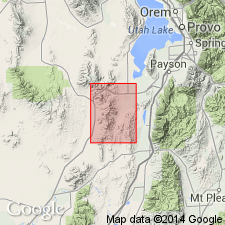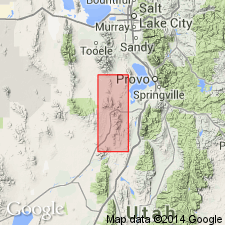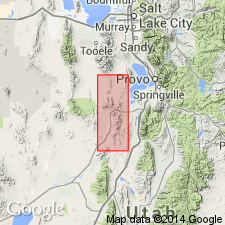
- Usage in publication:
-
- Bluebird dolomite*
- Modifications:
-
- Original reference
- Dominant lithology:
-
- Dolomite
- AAPG geologic province:
-
- Great Basin province
- South Western Overthrust
Summary:
Bluebird dolomite. Dark, bluish-gray fine-grained dolomite spangled with short white rods averaging 10 mm (2/3 inch) in length and 1 or 2 mm in width. Thickness 175 to 200+/- feet. Underlies Cole Canyon dolomite and overlies Herkimer limestone. Age is Middle(?) Cambrian.
Well exposed north of Eureka Gulch and west of Cole Canyon, along backbone of Bluebird Spur for nearly 1,000 ft, [in T. 10 S., R. 3 W.], Tintic district, [Juab Co.], central northern UT.
Source: US geologic names lexicon (USGS Bull. 896, p. 217-218).

- Usage in publication:
-
- Bluebird dolomite*
- Modifications:
-
- Areal extent
- Dominant lithology:
-
- Dolomite
- AAPG geologic province:
-
- Great Basin province
- Wasatch uplift
Summary:
Pg. 5 (fig. 2), 7-8. Bluebird dolomite. Described in East Tintic Mountains, where it is 150 to 220 feet thick, overlies Herkimer limestone, and underlies Cole Canyon dolomite. Consists of dusky blue-gray medium-grained dolomite studded with short white dolomite rods a centimeter or so long and 1 to 2 centimeters in diameter; white rods are straight, slightly curved, or branched and resemble minute twigs. Age is Middle Cambrian.
[See also Morris and Lovering, USGS Prof. Paper 361, Stratigraphy East Tintic Mtns.]
Source: US geologic names lexicon (USGS Bull. 1200, p. 393).
- Usage in publication:
-
- Bluebird dolomite*
- Modifications:
-
- Areal extent
- AAPG geologic province:
-
- Great Basin province
Rigby, J.K., 1958, Geology of the Stansbury Mountains, [Utah]: Utah Geological Society, Guidebook to the geology of Utah, no. 13, p. 1-134.
Summary:
Pg. 19, 20-21. Bluebird dolomite. In Stansbury Mountains, consists of dark-gray medium-crystalline dolomite, 75 to 80 feet thick, at base of Cole Canyon formation; overlies Bowman limestone. [Age is Middle Cambrian.]
Source: US geologic names lexicon (USGS Bull. 1200, p. 393).

- Usage in publication:
-
- Bluebird dolomite*
- Modifications:
-
- Areal extent
- AAPG geologic province:
-
- Great Basin province
- Wasatch uplift
Summary:
Pg. 36-39, 41 (fig. 18, twiggy dolomite). Bluebird dolomite. In ore-producing areas of the East Tintic Mountains, consists of massive, dusky-blue, medium to finely granular oolitic dolomite that contains many white vermicular or twig-like bodies averaging 10 mm in length and 1 to 2 mm in width. Conformably overlies Herkimer limestone; underlies Cole Canyon dolomite, contact placed at bottom of lowest white- to buff-weathering finely banded bed of the Cole Canyon. Dolomitic phase found chiefly near productive mines and areas of intrusive rocks in Tintic, East Tintic, and North Tintic districts. Thickness 150 to 200+ feet. Limestone phase virtually restricted to areas beyond limit of ore production. Limestone beds are medium-gray to dusky blue and fine grained, and only rarely contain the "twiggy" bodies. Fossils (trilobites identified by A.R. Palmer, USGS, 1953). Age is Middle Cambrian.
Measured section on south slope of Eureka Ridge, 1.25 mi south-southwest of Eureka, main Tintic district, in SE/4 sec. 24, T. 10 S., R. 3 W.; Bluebird 204.5 feet thick.
Source: Publication.
For more information, please contact Nancy Stamm, Geologic Names Committee Secretary.
Asterisk (*) indicates published by U.S. Geological Survey authors.
"No current usage" (†) implies that a name has been abandoned or has fallen into disuse. Former usage and, if known, replacement name given in parentheses ( ).
Slash (/) indicates name conflicts with nomenclatural guidelines (CSN, 1933; ACSN, 1961, 1970; NACSN, 1983, 2005, 2021). May be explained within brackets ([ ]).

